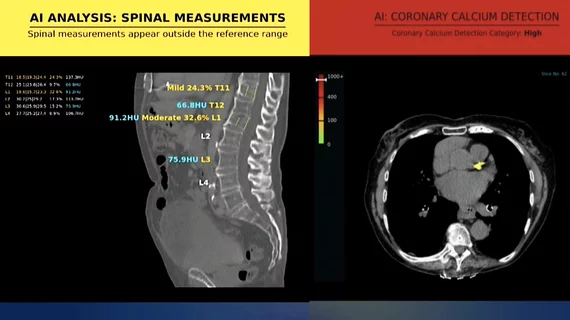Routine chest CT often reveals patients at risk for cardiovascular disease, presenting radiology with ‘untapped’ potential
Routine chest CT exams often reveal patients at risk for cardiovascular disease, presenting an “untapped population health resource” for the specialty, researchers detailed Monday.
Scientists recently conducted a literature review to help better understand opportunities in incidental heart imaging findings. Across more than 80 publications, the percentage of patients with such incidental coronary artery calcium ranged from 9% to 100%. However, when present, radiologists only reported this finding across about 31% to 44% of cases, experts wrote in JACR [1].
Initiating a more uniform approach to handling this concern could help pay dividends in improving cardiovascular care, argued Rubab Malik and co-authors.
“The field of radiology has the opportunity to bend the trajectory of [atherosclerotic cardiovascular disease] by providing opportunistic screening on every noncardiac chest CT performed,” Malik, with the Johns Hopkins University School of Medicine, and colleagues concluded. “And given the potential to improve health and reduce expenditure, consideration should be given to [incidental coronary artery calcium] reporting as a quality metric for the CMS Merit-based Incentive Payment System,” they added.
Across the studies analyzed, between 18% to 77% of patients with incidental coronary artery calcium were not on preventive medications for this concern. Seven of the studies measured the impact of radiologist reporting on guideline-directed medical therapy while five (71%) denoted an increase in medication prescriptions after diagnosis. Only one analysis, however, actually confirmed reductions in cholesterol levels.
For physicians, the key takeaway is to report this concern and consider working with others on the care team to address it.
“Reporting is just the first step in a concerted effort to optimize care for patients with increased risk of [atherosclerotic cardiovascular disease]-related morbidity and mortality,” Malik and co-authors advised. “Performance improvement champions are encouraged to develop high reliability systems to ensure downstream care. For patients who present to the emergency department without primary care access, radiologists should partner with emergency medicine physicians to capitalize on the opportunity to inform patients about the new diagnosis of preclinical ASCVD disease and arrange ambulatory care. Partnership with cardiology is equally important, to develop clinically and cost-effective management paradigms that provide guard rails against an increase in low value testing and interventions.”
There is growing interest across radiology to use opportunistic imaging, possibly with artificial intelligence, to look at all types of medical scans in the background for incidental findings for various diseases. This was discussed in several sessions at the 2023 RSNA meeting. This could help the patient with earlier detection of disease.

